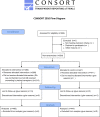The effect of the use of a decision aid with individual risk estimation on the mode of delivery after a caesarean section: A prospective cohort study
- PMID: 31557177
- PMCID: PMC6763212
- DOI: 10.1371/journal.pone.0222499
The effect of the use of a decision aid with individual risk estimation on the mode of delivery after a caesarean section: A prospective cohort study
Abstract
Objective: After one previous caesarean section (CS), pregnant women can deliver by elective repeat CS or have a trial of labor which can end in a vaginal birth after caesarean (VBAC) or an unplanned CS. Despite guidelines describing women's rights to make an informed choice, trial of labor and VBAC rates vary greatly worldwide. Many women are inadequately informed due to caregivers' fear of an increase in CS rates in a high VBAC rate setting. We compared counseling with a decision aid (DA) including a prediction model on VBAC to care as usual. We hypothesize that counselling with the DA does not decrease VBAC rates. In addition, we aimed to study the effects on unplanned CS rate, patient involvement in decision-making and elective repeat CS rates.
Methods: We performed a prospective cohort study. From 2012 to 2014, 483 women in six hospitals, where the DA was used (intervention group), were compared with 441 women in six matched hospitals (control group). Women with one previous CS, pregnant of a singleton in cephalic presentation, delivering after 37 weeks 0 days were eligible for inclusion.
Results: There was no significant difference in VBAC rates between the intervention (45%) and control group (46%) (adjusted odds ratio 0,92 (95% Confidence interval 0.69-1.23)). In the intervention group more women (42%) chose an elective repeat CS compared to the control group (31%) (adjusted odds ratio 1.6 (95% Confidence interval 1.18-2.17)). Of women choosing trial of labor, in the intervention group 77% delivered vaginally compared to 67% in the control group, resulting in an unplanned CS adjusted odds ratio of 0,57 (0.40-0.82) in the intervention group. In the intervention group, more women reported to be involved in decision-making (98% vs. 68%, P< 0.001).
Conclusions: Implementing a decision aid with a prediction model for risk selection suggests unchanged VBAC rates, but 40% reduction in unplanned CS rates, increase in elective repeat CS and improved patient involvement in decision-making.
Conflict of interest statement
The authors have declared that no competing interests exist.
Figures
References
-
- NICE, Caesarean Section, clinical guideline. 2011, London: National Collaborating Centre for Women's and Children's Health. - PubMed
-
- RCOG, Birth after previous caesarean birth. Green-Top Guideline, 2015.
Publication types
MeSH terms
LinkOut - more resources
Full Text Sources


